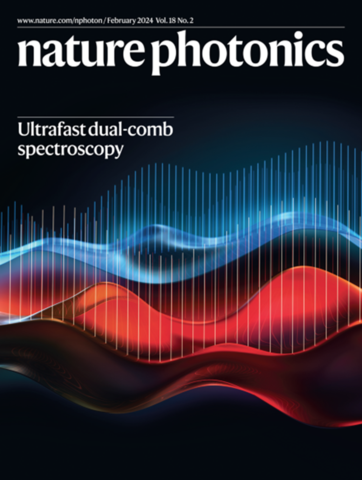David Long ()
Project Leader

An artistic image of a dual-frequency comb that is generated by using an optical parametric oscillator to convert a pair of near-infrared combs into the mid-infrared. The generated combs enable nanosecond-timescale spectroscopy for probing the ultrafast dynamics found in supersonic gas jets, explosions and chemical kinetics.
David Long received his PhD in chemistry from the California Institute of Technology under the guidance of Mitchio Okumura. He then moved to the National Institute of Standards and Technology where he is currently a project leader in the Photonics and Optomechanics group.
Dr. Long’s research has focused on the development and application of ultrasensitive spectroscopic methods to present problems in optomechanics, and quantum science. Electro-optic frequency combs have been a particular focus of his work and have been applied in areas such as physical metrology, ultrafast dynamics, and atomic sensing. Recent efforts have transitioned these approaches to chip scale, integrated photonic platforms as well as demonstrated spectral translation of these combs throughout the visible and mid-infrared through the use of optical parametric oscillation.
Dr. Long’s work has been recognized by a number of awards including the Presidential Early Career Award for Scientists and Engineers, the National Science Foundation Graduate Fellowship, the Department of Commerce Silver Medal, the Sigma Xi Young Scientist Award, the National Defense Science and Engineering Fellowship, the Barry M. Goldwater Scholarship, and the Morris K. Udall Scholarship.
Research Interests
- Optical frequency combs
- Molecular spectroscopy
- Integrated photonics
- Physical sensing
- Nonlinear optics
- Quantum science
Awards
- Coblentz Award (2024)
- Department of Commerce Silver Medal (2023)
- Presidential Early Career Award for Scientists and Engineers (PECASE) (2019)
- NIST Sigma Xi Katherine B. Gebbie Young Scientist Award (2018)
- National Science Foundation Graduate Fellowship (2007)
- National Defense Science and Engineering Fellowship (2007)
- USA Today All-College Team Honorable Mention (2007)
- Finalist for the Rhodes and Marshall Fellowships (2007)
- Graduated as valedictorian and summa cum laude from Kenyon College (2007)
- Morris K. Udall Scholarship (2006)
- Barry M. Goldwater Scholarship (2005)

